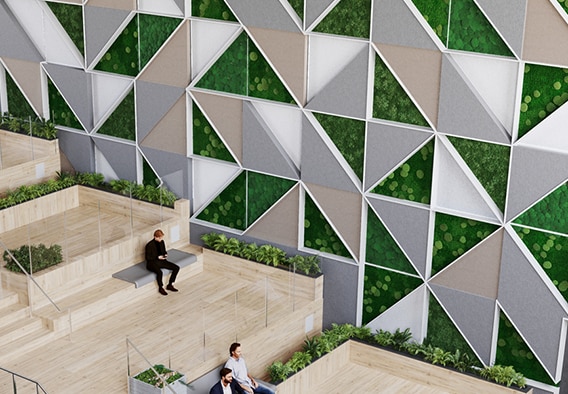Where to Place Acoustic Panels
Acoustic comfort is an important feature in the realm of interior design. It can boost concentration and productivity level in an office buildings or reception areas. Sound bounces and reverberates off ceilings, floors, walls, furniture, and other surfaces, affecting individuals differently depending on its intensity and intrusiveness.
Considering the adverse physical and psychological effects of noisy environments, there is an increasing demand for sound dampening solutions, such as acoustic wall panels made with preserved natural moss. Quiet Earth acoustic moss panels are popular in the modern workplace with open floor plans. The intrusive sounds of ringing phones, conversations, computer equipment, foot traffic, and background clamor hamper concentration and work performance.
Unlike utilitarian sound-absorbing panels from the past, our moss panels are elegant solutions that elevate aesthetics while tempering disruptive noise. However, when it comes to the placement of acoustic panels for maximum effect, there are several factors to consider.
Where to Place Acoustic Panels
Use the following guidelines for best-practice approaches to acoustic panel placement.
- Consider the dimensions of the room or space where you want to improve acoustic comfort
- Larger, highly populated areas will typically benefit from acoustic panels installed at the same level where the sound is being generated. For example, if most occupants are seated at desks, the panels should be placed 3 or 4 feet off the ground to absorb the greatest amount of sound. On the other hand, if people are standing more than sitting in enclosed areas, aim for placing panels between 5 and 7 feet off the ground where the strongest vibrations emanate.
- Spacing is also essential. Acoustic moss panels may be less effective (both functionally and aesthetically) if installed side-by-side on a single wall. Instead, strive for a more symmetric and balanced placement that considers windows, A/C vents, doors, exit signs, and other common obstructions.
- Try to minimize any discrepancy in spacing between acoustic panels whenever possible.
- To negate standing sound vibrations that develop between parallel walls, treat both with acoustic panels placed at the same height.
- Panels placed too high will have less efficient sound dampening properties, as it will take longer for sound waves to reach the absorbent material.
- Place acoustic panels in corners or “dead spots” where echoes and sounds tend to build up.

Acoustic Panel Placement
Generally speaking, a busy office environment may only need 5 to 10 percent of acoustic wall coverage to create a more pleasant environment free of ambient noise. Room shape and size will also impact the placement of preserved moss wall panels.
For standard square or rectangular-shaped rooms, shoot for regular spacing of panels-- equidistant apart-- around the perimeter.
Rooms that are especially wide or long present more of a challenge because sound waves have farther to travel and more time to disperse. In these situations, designers may need to cover more surface area with acoustic panels to achieve the same effect.
Where to Place Acoustic Panels on the Ceiling
When installed on the ceiling, acoustic panels soak up sound waves that can travel to adjacent rooms. In addition, vaulted ceilings can help control ambient noise if the ceiling is high enough that the sound waves lose energy before being deflected down.
Quiet Earth acoustic moss panels are mounted on lightweight ezoBord that can be screwed directly to ceiling plywood or drywall. Depending on your structural material, 1 ¼” to 2 ¼” screws may be sufficient. Our experienced team is happy to recommend the best method and placement strategy for installing moss panels.
Contact us at Quiet Earth for Biophilic Solutions
Acoustic comfort is an integral component of biophilic interior design for modern commercial spaces that promote health, wellness, and productivity.
Interested in learning more about Quiet Earth acoustic moss panels and placement for maximum efficacy? Contact us today to speak with a representative in your area.






